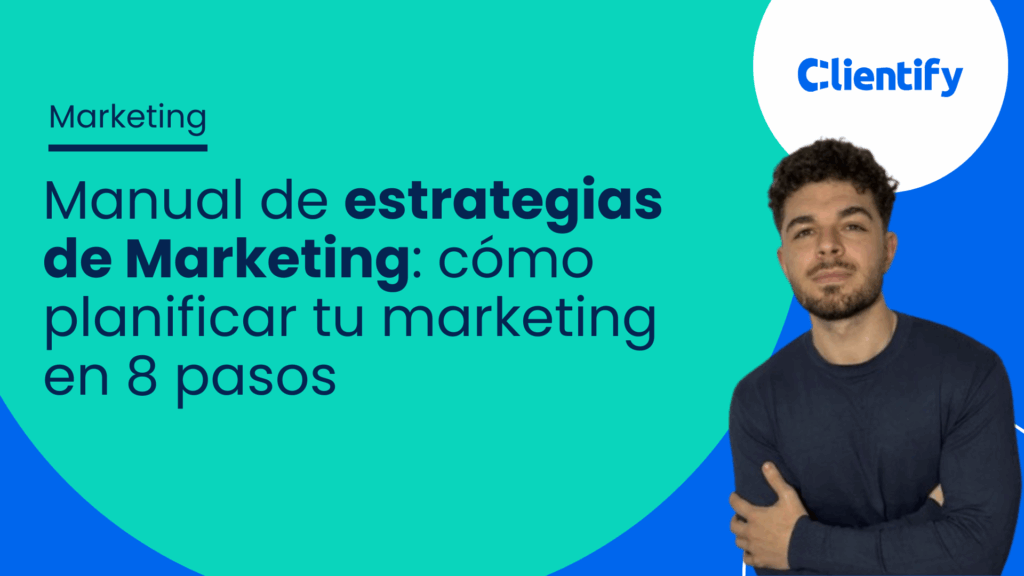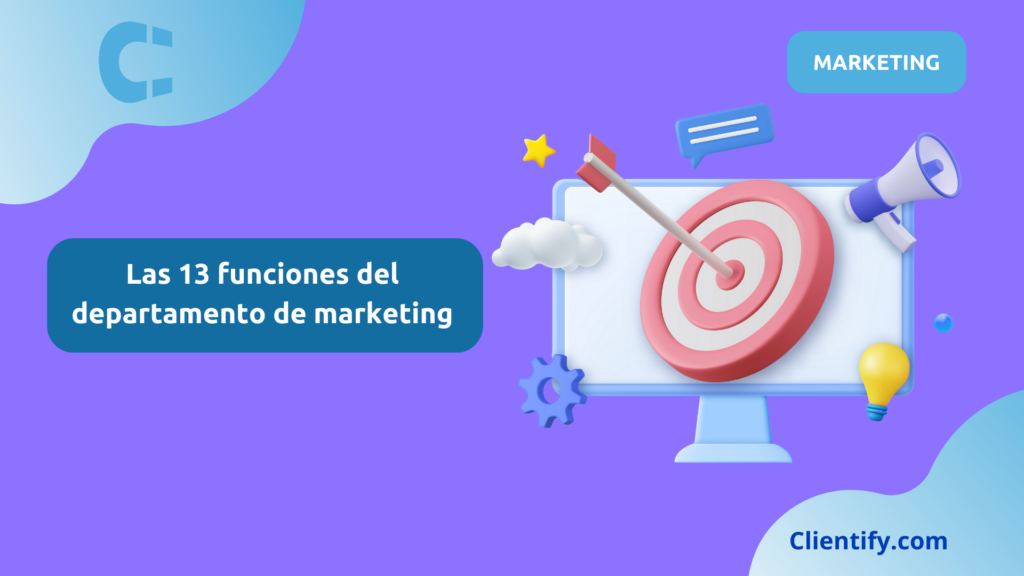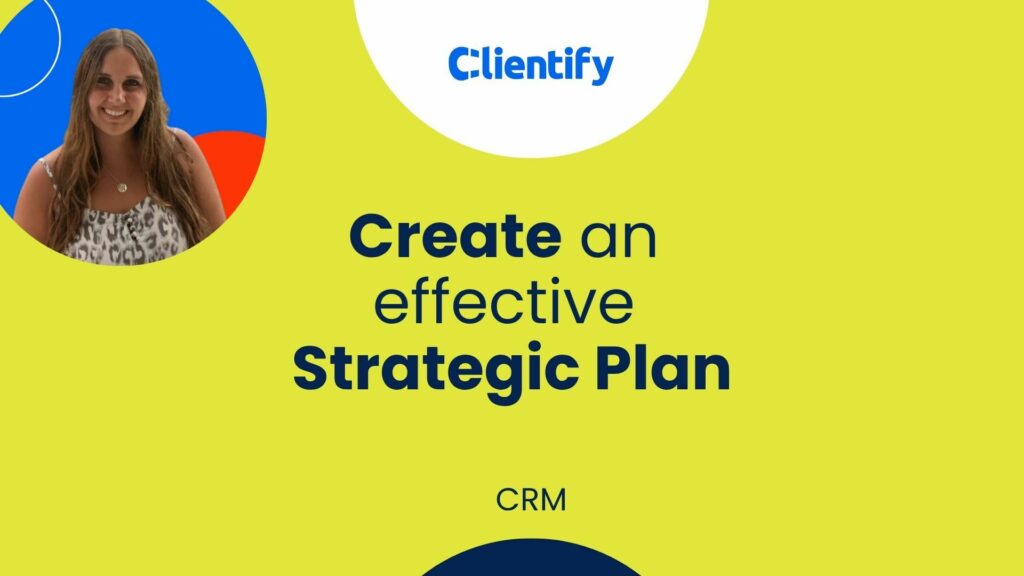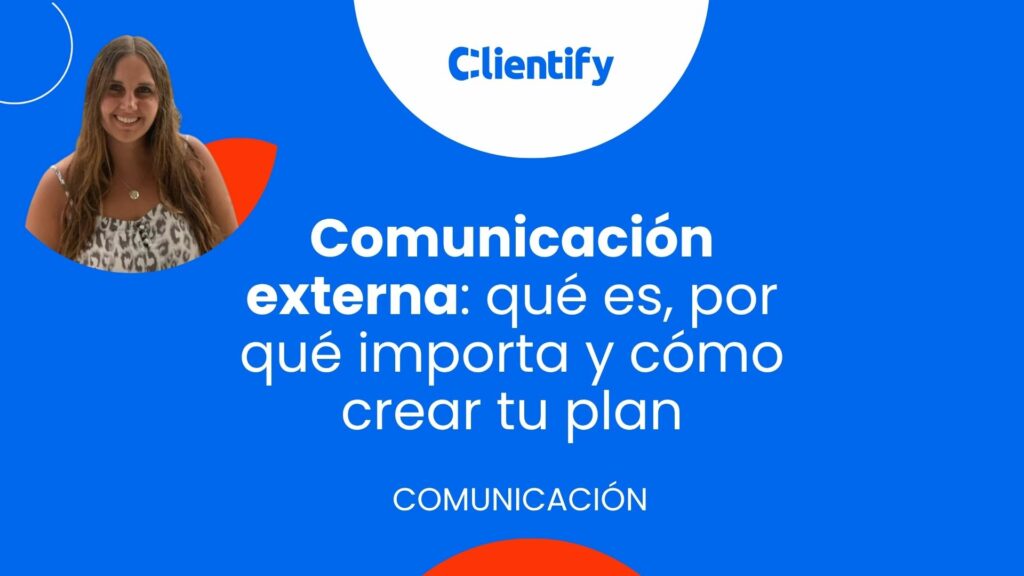For me, marketing has never been just about selling.
It’s about providing real value, about people trusting you and keeping you in mind beyond a one-off campaign.
And I’ll tell you something I’ve learned through trial and error: it’s no use knowing the theory of what a marketing strategy is if you don’t have a clear plan to bring it down to earth and the right tools to execute it.
That’s where most get lost, myself included at first.
That’s why in this post I want to tell you what I would have liked to read when I started:
Key ideas:
- What is a marketing strategy?
- What are its key elements?
- What types of strategy can you design
- Step by step how to create a marketing strategy with Clientify
What is a marketing strategy?
Before launching into a strategy, you need to be clear about what it means.
A marketing strategy is a detailed action plan that seeks to achieve business objectives through a coherent set of tactics and actions.
This includes everything from market analysis and segmentation of your audience to the value proposition and communication channels you will use to reach them.
And when you work with the right tools, this whole process becomes easier.
What are the key elements of a marketing strategy?
If you do not define well what, for whom and how you are going to measure the success of your marketing strategy, it is neither a strategy nor a marketing strategy, let me tell you that you will not be able to achieve much.
I have seen too many companies improvise, jumping from campaign to campaign aimlessly.
Result: money wasted and zero learning.
To avoid this, these are the elements that are never missing when you want your marketing strategy to work.
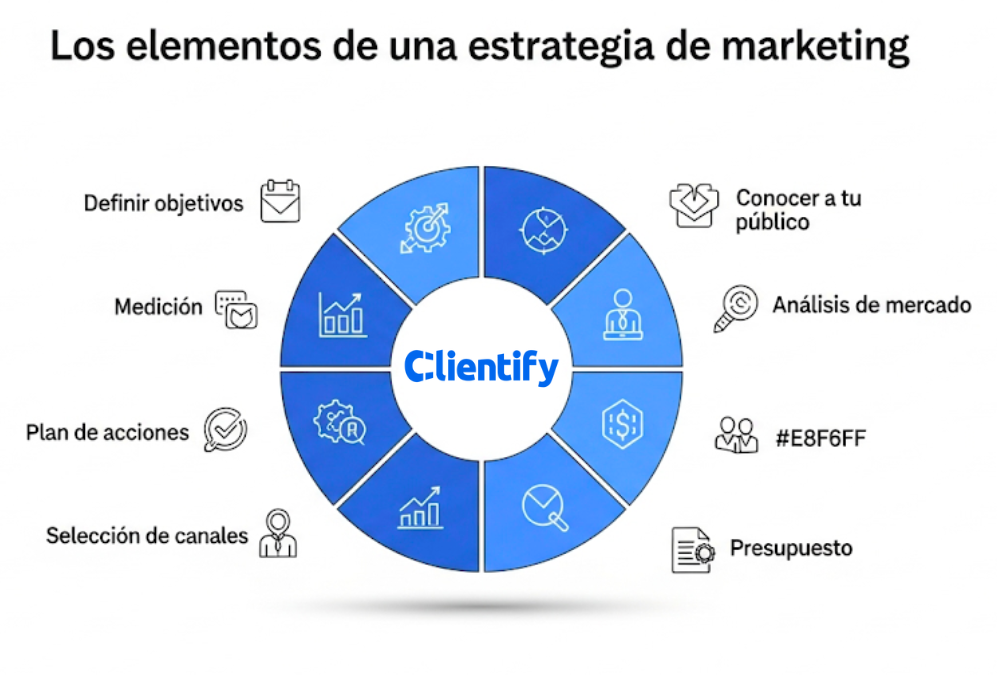
1- Define clear and measurable objectives
A classic mistake is to say “I want to sell more” and believe that this is an objective.
It is not.
Objectives must be SMART (Specific, Measurable, Achievable, Relevant and Time-bound).
For example: “close 50 new real estate clients in the next 4 months”.
Without that pressure, marketing becomes a game of likes, and likes don’t pay bills, they are vanity metrics.
2- Knowing your audience (ICP and buyer persona)
There is a lot of skating here.
Selling to an SME with 10 employees is not the same as selling to an agency with a turnover of 5 million.
They have different pain, different decision times and even different channels.
If you define your ICP (ideal customer profile) well and downgrade it to buyer personas, communication changes, you start to speak their language, use examples they recognize, and suddenly your proposal sounds like “this is for me”.
3- Market and competition analysis
I say it clearly: if you don’t analyze your competition, you go naked to the battlefield.
Make a SWOT (or SWOT, whatever you like to call it) and look at yourself in the mirror: what are you strong in, what are you not strong in?
In addition, understanding the market gives you golden insights.
Example: in Spain, only 28% of companies use a CRM, but this figure is growing at 12.7% per year (Eurostat data).
This is a clear sign of opportunity that many ignore.
4- Value proposition and positioning
This point often hurts: what really makes you different?
If the answer is “price”, we are in trouble.
A good value proposition is one that your customer can repeat by heart: “This tool saves me 5 hours of work per week” or “with them I close 30% more leads”.
Define your territory and defend it, if you don’t choose how to position yourself, the market will put an equal label on you… and it’s almost never the one you want.
5- Channel selection and tactics
Don’t try to be everywhere, that’s resource suicide.
Choose well: SEO and content to capture demand, LinkedIn Ads if you are in B2B and need speed, email/WhatsApp to nurture and close.
The important thing is not the list of channels, but to know what role each one plays in your funnel.
And here I tell you something personal: I have seen SMEs double their sales only with a good CRM for WhatsApp, without spending a euro on ads.
6- Action plan and timetable
Ideas are cheap, it’s the execution that costs, and that’s where the calendar comes in.
Define what is done each week, who does it and what is expected as a result, if you leave it at “we’ll get to it”, it never happens.
At Clientify we always insist that an editorial and campaign calendar is the difference between having order or living putting out fires.
7. Budget and resources
Nobody makes this clear: your strategy is worth your budget.
With 500 € per month you can’t expect the same as with 5.000 €, don’t get frustrated, but be realistic.
Distribute well: equipment (internal or external), tools and a cushion for testing.
The most common mistake is to spend everything on ads and forget about the measurement or content part, and that’s where you lose money.
8- Measurement, control and continuous improvement
What is not measured does not exist.
Define KPIs that matter: leads, CAC, conversion, LTV, set up dashboards, review each week and adjust.
Companies that review their metrics on a monthly cadence grow up to 2 times faster than those that only “take a look once in a while”.
The secret is not to measure for the sake of measuring, but to learn and correct without fear.
What are the main 13 types of marketing strategies?
When it comes to marketing strategy, there are hundreds of different strategies.
Each company has its own context, budget and level of maturity.
What works for a multinational with millions in Ads is not the same as what works for an SME starting with a CRM.
Here are the most common types of marketing strategies (and when to use them).
1- Digital marketing strategy
The most widespread today.
This is where other strategies such as SEO, paid campaigns, email marketing, social media, content… everything that happens in the online world comes in.
The trick? Not to fall into the trap of “being everywhere”, better to choose few channels and exploit them well.
2- Inbound marketing strategy
Inbound is about attracting customers with valuable content: blogs, ebooks, webinars, newsletters… instead of chasing them, you make them come to you.
It is slow, but very profitable in the long run today any SME with good content and a CRM can apply it.
3- Outbound marketing strategy
Outbound is the “I’m coming for you” instead of “I’ll wait for you”, and although it may seem unbelievable, it is a complementary strategy to Inbound.
We are talking about calls, LinkedIn campaigns, cold emails or even mass advertising. Many criticize it for being intrusive, but the reality is that done well it shortens sales cycles and puts your brand in front of the decision maker.
The key to making it work is not to sound spammy: personalize messages, segment well and use multi-channel sequences that mix email, calls and LinkedIn.
For example, a B2B agency can open conversation on LinkedIn, reinforce with a valuable email and close with a call.
4- Content marketing strategy
Create and distribute interesting content for your audience: guides, tutorials, case studies, benchmarks.
Content is the fuel that feeds SEO, social media and even outbound (yes, sending a powerful post in a cold email works better than an empty pitch).
5- Relationship marketing strategy
The focus here is not to attract, but to build loyalty.
It focuses on building long-term relationships with your customers: loyalty programs, post-sales email, follow-up WhatsApp, exclusive events.
It makes sense: a retained customer costs 5 times less than acquiring a new one (source: Harvard Business Review).
6- Data-driven marketing strategy
Marketing is no longer intuition when you use data:
- CRM
- dashboards
- web analytics.
Measuring CAC, LTV, conversion and ROI is what determines whether you are throwing money away or investing it, those who measure, improve; those who don’t, remain in “I think it works”.
7- Local marketing strategy
If you sell in a specific geographic area, this is key.
Optimize Google Business Profile, local SEO, reviews and segmented campaigns by location.
Ideal for physical businesses, real estate, clinics, opticians or restaurants.
8- Influencer marketing strategy
Align with people who already have the trust of your audience.
I’m not just talking about macro-influencers, but micro-creators that in their niche drag community, it can be a brutal channel if it fits with your product.
8- Growth marketing strategy
This is the most experimental part.
Rapid testing, iterations and channel mix to find levers that scale: A/B testing, automation, referral programs, recruitment hacks.
Perfect for startups or small teams that need to grow without big budgets.
9- Hyper-personalized marketing strategy (with AI)
Generic marketing is dead.
Today’s customers expect you to talk to them, not to an anonymous mass, and AI makes this possible.
Platforms that analyze the behavior of each user make it possible to adjust messages, offers and delivery times in detail.
Powerful fact: according to IBM, hyper-personalization with AI can reduce the cost of customer acquisition by up to 50%.
In other words, segmentation is no longer enough: it is now about personalization at the individual level.
10- Conversational marketing strategy
WhatsApp, chatbots and AI assistants have become another sales channel.
People don’t want to fill out endless forms: they want an immediate and personalized response.
Here we are talking about bots that answer questions, close appointments and even qualify leads before a human touches them.
Without going any further, Clientify (us), we are specialized in just this, we are a platform that covers all communication related to WhatsApp, Chatbots, inboxes, IAs and much more.
In B2B this is gold, because you reduce friction and accelerate the sales cycle.
11- Experiential marketing strategy
Not everything is online.
More and more brands are betting on experiences that the customer remembers: face-to-face events, workshops, pop-ups or even immersive experiences with augmented reality.
The logic? A customer who experiences something unique with your brand not only buys, but becomes an ambassador.
In sectors such as real estate or retail, product experiences (virtual tours, interactive demos) are already standard.
12- Omnichannel marketing strategy
Today’s consumer moves between online and offline without friction: they see an ad on Instagram, search for reviews on Google and end up buying in the physical store.
The omnichannel strategy ensures that the message is consistent across all touch points.
This is not just “being on many channels”, but that the user feels continuity: same tone, same experience, same follow up.
And this is where a CRM like Clientify helps: because it connects sales, marketing and communication in one place, preventing each channel from going it alone.
The step-by-step guide on how to create your marketing strategy
Creating a marketing strategy may sound like a gigantic project, but the reality is that if you break it down into concrete steps, the process becomes much more digestible.
Here is the route that any business, whether you are an SME, an agency or a startup, should follow to design your plan.
Define clear objectives:
Start with clear goals, no “I want more sales”.
Think about objectives that are specific, measurable and time-bound.
Example: “get 200 qualified leads in three months”, this point is the one that gives direction to everything else.
Step 2. Know your audience
Do your research homework:
- Who is your ideal customer?
- What pains do you have?
- How do you buy?
And talk to them, interact with them, really get to know them.
Step 3. Analyze your market and competition
Look at what others are doing and what trends are moving your sector, not to copy, but to find gaps.
Sometimes the difference is in the small details: better service, faster service, a different communication channel…
Step 4. Define your value proposition
Here you must answer, “Why should they choose me and not someone else?”.
If you are not clear about it, you have to work on it. A powerful value proposition does not only talk about the product, but also about the benefit that the customer gets.
Step 5. Choose your channels
Decide how you are going to reach your audience: SEO, social networks, email, WhatsApp, digital advertising, events…
You don’t have to be in all of them, just the ones that fit your audience and your objectives.
Step 6. Choose your tools
You need a place to measure, automate and centralize your efforts.
Choose tools that allow you to reach your goals and fulfill your channels.
For example, with an all-in-one CRM like Clientify you can have in the same panel your contacts, email and WhatsApp campaigns, analytics, results, billing and everything that has to do with sales, marketing or communication.
Step 7. Design your action plan
Stop with the “we should do…” and move on to “this will be done on Tuesday at 10 o’clock”, set up a plan with clear actions, responsibilities and dates.
Example: “publish 2 blog posts per month”, “launch LinkedIn Ads campaign on the 15th”, “send newsletter every Thursday”.
The important thing is that each action is connected to your objectives.
Step 8. Run
Execution is where most get stuck, don’t try to do everything at once or open 20 fronts.
Prioritize what has the most impact and start there, keep it simple: fewer ideas, more consistency.
Tools play a key role: Look for tools that allow you to have everything centralized: campaigns, leads, tasks, so you don’t end up chasing data on 10 different platforms.
Step 9. Measure and optimize
If you don’t measure, you don’t learn, define your business KPIs (leads, conversion, ROI, cost per acquisition…) and review them on a weekly or monthly basis.
Don’t wait for the quarter to pass before reacting.
The key is to have the habit of adjusting quickly: if a channel doesn’t work, change it; if a campaign works, double the budget .
Strategies that work are not static, they are alive and evolve according to the data.
16 examples of marketing strategies that inspire (and really work)
It’s one thing to talk about theory and quite another to see how marketing strategies are applied in real life. Here are some cases that show that when an idea is well executed, results come.
These are the 16 success stories we are going to see:
- H&M – hyperpersonalization with AI
- Sigter Colombia – inbound marketing with CRM
- Netflix – predictive recommendations with hyperpersonalization
- Sephora – bot in Messenger (conversational marketing)
- KLM – WhatsApp/Messenger (conversational marketing)
- Volkswagen – piano staircase (experiential marketing)
- Mountain Dew – guerrilla tour (experiential marketing)
- Leroy Merlin – omnichannel strategy
- Sephora Play! – omnichannel community
- Distinctive + Edrone – automation
- Eñutt Communication – automation + omnichannel
- DIA – loyalty program
- Starbucks Rewards – gamified loyalty
- Storykit + HubSpot – digital + paid
- Credo – creative outbound marketing
- Estrella Damm – branded content (content marketing)
H&M: hyper-personalization with AI to sell more fashion
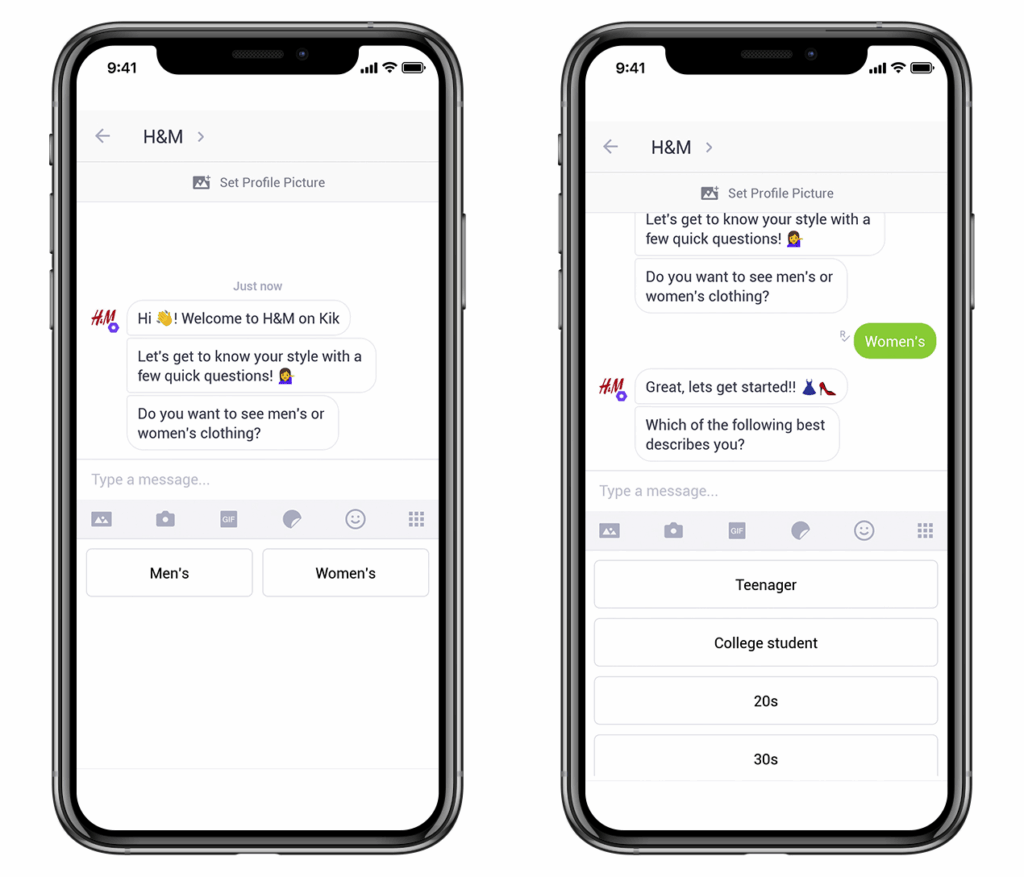
H&M got tired of sending generic newsletters and started using AI chatbots to recommend outfits based on each customer’s style and preferences. It’s no longer just “I sell you clothes”, but “this outfit fits you”.
The result: more engaged customers and an increase in the average ticket.
The lesson here is clear: the more personalized the experience, the closer you are to closing the sale.
Sigter Colombia: inbound marketing with a monthly turnover of more than US$25,000
Sigter Colombia, a digital agency, decided to stop chasing clients and set up an inbound funnel with Clientify: consulting lead magnets, email and WhatsApp automation, and a CRM that aligned sales and marketing.
The change was brutal: they began to attract SMEs in the health sector and today they invoice more than 25,000 USD per month with this strategy alone.
The key? It’s not theory: it’s having the entire process centralized and automated, from lead capture to closing.
Netflix: predictive recommendations that engage the user
If there is a master of hyper-personalization, it is Netflix. Its algorithm analyzes what you watch, how long it takes you to leave it and even what time you usually consume content.
Thanks to that, 80% of what users play comes from their personalized recommendations(source).
The lesson is obvious: if you give the customer just what he wants when he wants it, he stays with you.
Sephora: a Messenger bot that sells more makeup
Sephora understood early on that conversations sell. Its Facebook Messenger bot does a quick test on your skin type, style and needs, and then recommends products with a direct link to purchase.
The moral: people don’t want to scroll endlessly through your catalog; they want you to guide them and solve their life in two clicks.
KLM: customer service on WhatsApp and Messenger
The airline KLM has made messaging its main customer service channel. For years now, you have been able to confirm flights, receive your boarding pass or resolve incidents directly via WhatsApp or Messenger.
No eternal call centers. With this they were able to reduce waiting times and increase customer satisfaction.
The learning? If your business offers convenience and speed on channels that people already use, loyalty goes up on its own.
This is one of the strongest points of Clientify, it allows you to have a centralized and multi-user “inbox”, where you can answer from a single place all messages from WhatsApp, email, Facebook, instagram…
Volkswagen: a staircase that became a piano
In Stockholm, Volkswagen installed a subway staircase that sounded like a piano when people stepped on it. The result?
66% more people chose the regular ladder over the escalator. They didn’t sell cars there, but they did sell what’s most valuable: a fun, creative and approachable brand.
Learning: experiential marketing does not always seek direct sales, it seeks to stay in the customer’s head.
Mountain Dew: guerrilla tour with brutal ROI
Mountain Dew launched with a guerrilla street marketing tour, creating experiences with music, activations and free trials.
The data? They generated an ROI of €1.85 for every euro invested, and 55% of the attendees ended up buying and sharing in networks.
A rounded campaign: live engagement + online virality + real sales. The moral is clear: when the experience is powerful, people become your best distribution channel.
Leroy Merlin: omnichannel that boosts sales
Leroy Merlin Spain decided to stop separating “physical store” and “online” to unify the experience.
They bet big: more than 500 million euros invested in digital and marketplace, with an app that already represents 25% of online sales and grew 121% in one year. Result: +40 % online sales by 2024.
Clear lesson: when channels talk to each other, the customer buys more and better.
Sephora Play!: digital and physical community
Sephora understood that loyalty is not bought with discounts, but with community, its Sephora Play! program connects physical samples, in-store events and online content with beauty influencers.
Thus, a customer who tries a product in store continues to receive recommendations and tutorials in digital.
Learning: omnichannel is not just about logistics, it’s about building a consistent end-to-end customer journey.
Distinctive + Edrone: automation that boosts sales
The fashion brand Distinctive decided to stop relying solely on manual campaigns and opted to automate its marketing processes with edrone.
They set up email, pop-up and SMS scenarios to automatically nurture customers.
The result? They doubled the average order value, increased annual customer value by 45% and increased turnover by 22%. Learning: automation is not posturing, it’s more revenue with the same team.
Clientify – Eñutt Comunicación: everything in one place
The Eñutt agency explains it brutally: “Managing marketing without a good tool is like juggling four balls while skating on ice”.
Previously they had tasks scattered across multiple platforms; now, with Clientify,they centralize email, WhatsApp, campaigns and analytics in a single CRM.
The result: more control, less chaos and, above all, more sales thanks to automation.
The moral is that a good CRM is the operating system of your marketing.
DIA: loyalty with constant data and rewards
The DIA supermarket bet on its Club DIA and omnichannel app to engage customers beyond price.
Today, they already have more than 6 million members, who achieve an average annual savings of 25%, and the famous “Lucky Roulette” has distributed almost 3 million prizes.
Learning: loyalty is not just about points cards, it is about offering tangible and constant benefits that turn each purchase into a habit.
Starbucks Rewards: habit-forming rewards
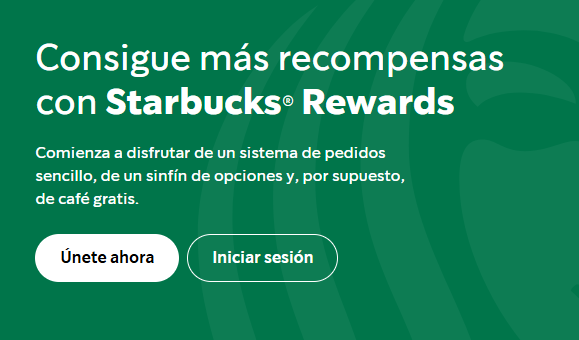
Starbucks doesn’t sell coffee, it sells belonging.
Its Starbucks Rewards program personalizes rewards based on consumption habits and multiplies visits. Each purchase accumulates points that translate into free drinks, upgrades or surprises.
Result: millions of repeat customers worldwide.
The lesson is clear: when you build loyalty well, the customer stops “thinking about where to go” because he already has his reference brand.
Storykit + LinkedIn Ads: digital with intelligent reporting
Storykit combined Inbound with LinkedIn Ads campaigns and reporting automation.
The change was dramatic: they reduced their lead scoring and reporting time by 50%, allowing them to devote more resources to working with quality leads instead of wasting hours on repetitive tasks.
Learning: digital marketing is not just about spending on Ads, it is about knowing how to measure and optimize every euro invested.
Credo: creative outbound with “Déjate de cuentos”.
The agency Credo designed a campaign for the College of Psychology of Eastern Andalusia called “Déjate de cuentos”, using illustrations and metaphors from children’s stories to talk about mental health.
It was pure outbound: clear, direct messages, disseminated in the media and advertising media.
The result: it won three creative awards at Publifestival and managed to put a complex topic on everyone’s lips.
Learning: outbound works if you have a powerful message and you launch it with creativity.
Estrella Damm: branded content that replaces ads
Instead of the usual 20-second spot, Estrella Damm opted for a music video clip of several minutes as a summer campaign.
If you live in Spain, I’m sure it brings back good memories.
The piece not only became the song of the summer, but also a brand experience that connected with millions of people.
Teaching: Content marketing can be much more effective than traditional advertising when you create something that people want to see, hear and share.
Conclusion
If you look at it, it doesn’t matter if we’re talking about H&M with AI, an irreverent campaign like KFC‘s, a loyalty program like Starbucks, or Sigter Colombia scaling up with Clientify.
They all have one thing in common: focused execution and consistency between strategy and tools.
Marketing that works today is not about doing “one-offs”, it’s about putting together a system that combines creativity, data and technology.
And therein lies the opportunity: if big brands do it with millions of euros, SMEs and agencies can also do it with the right tools and a clear strategy.
In the end, the important thing is not to copy the campaigns, but to understand the principle behind each example and adapt it to your business.
And if you want to centralize your channels, automate processes and measure results without getting lost in ten different platforms, Clientify can be the engine that makes your strategy stop being theory and start being results.
We invite you to try these tools with a 14-day free trial or request a free demo to discover how they can help you improve your marketing strategies.

